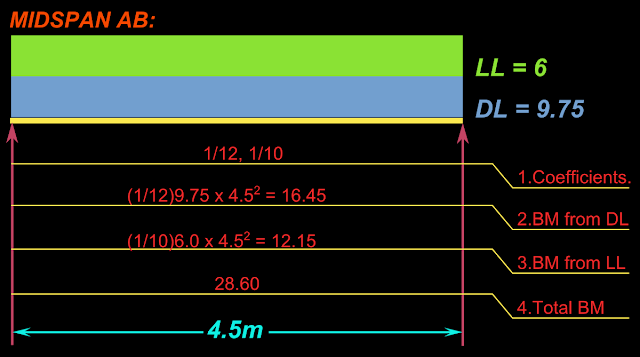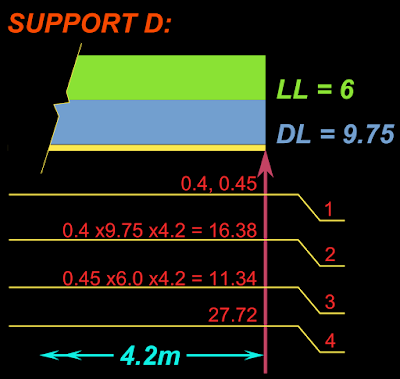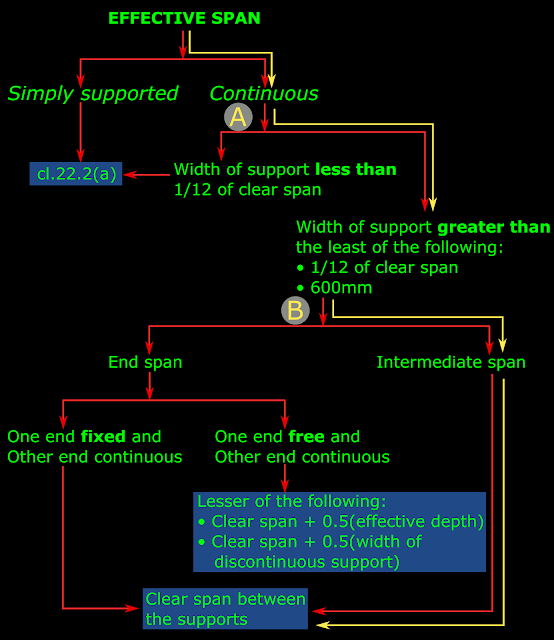In
the previous section we saw the detailed procedure of analysis of a continuous one-way slab. By doing the analysis, we obtained the BM and SF at various points of the slab. In this section we will see an alternate method to obtain these BM and SF. This method is called the 'Method of coefficients'. In this method, we do not have to make a complete structural analysis using Slope deflection method, Moment distribution method, Kani's method etc., We can obtain BM and SF of any span just by multiplying the length of the span and the load with some coefficients. So this is an easy method. But to use this method, the continuous one-way slab (or beam) should satisfy certain conditions:
• The beam section for all the spans should be uniform
• The loading should be substantially uniformly distributed load.
• There must be three or more spans.
• The lengths of the spans should not differ by more than 15% of the longest.
• When we use this method, we must not carry out 'moment redistribution'
If these conditions are satisfied, we can use the coefficients given in the tables 12 and 13 of the code (cl.22.5.1) for obtaining the bending moment and shear forces for the design.
Let us see if the above conditions are satisfied in our case:
• The section is uniform for all the spans. Because, the width of cross section of the beam is 1000 mm, and the depth of cross section is 200mm through out the length of the slab.
• The loading type is 'Uniformly distributed'
• No. of spans in our case is three
• Length of the longest span is 4.5m. 15 % of this is 0.675m.
♦ Difference in length between the second span and the longest is 4.5-4.0=0.5m < 0.675m.
♦ Difference in length between the third span and the longest is 4.5-4.2=0.3m < 0.675m.
• We are not doing moment redistribution for our beam.
So all the conditions of cl.22.5.1 are satisfied. Now let us see the details of table 12 of the code.
According to the note below table 12, "to get the bending moment, we must multiply the coefficient by the 'total design load' and the effective span". - - -(1)
The total design load is equal to the 'design load per meter' multiplied by the effective span.
That is., Total design load =wu l - - - (2)
According to (1), we must multiply (2) again by l. So the bending moment can be obtained as follows: By multiplying the coefficient by the design load per meter and the square of the effective span. That is.,
BM = coefficient x wu l2. - - - (3)
Using the above information, let us now calculate the BM at various points:
From the second column (which is under 'span moments') in table 12, we can obtain the following bending moments:
Bending moment near the middle of end span (span AB) due to DL:
Coefficient = 1/12; wu =9.75; l=4.5
So BM = 1/12 x 9.75 x 4.52 = 16.45 kNm
Bending moment near the middle of end span (span AB) due to LL:
Coefficient = 1/10; wu =6.0; l=4.5
So BM = 1/10 x 6.0 x 4.52 = 12.15 kNm
So the total BM due to DL and LL = 16.45 +12.15 =28.6 kNm
This value is close to the value of 28.44 kNm which we obtained earlier in fig.7.11
In this way, we can obtain the BM at the other points of the beam. The tables in the following fig.7.14 show the calculation steps:
Fig.7.14
Note that, the coefficients for Spans AB and CD are the same because they are both end spans.
Now we will see the negative (hogging) BM at supports. The BM at end supports for this problem will be zero because they are simply supported. So we need to calculate the BM at intermediate supports only. At any intermediate support, the BM will be influenced by the magnitude and type of loads, and also the length of the span on either side of the support. So if the two spans are not equally loaded and/or they have unequal spans, we will get two different values. One from the left side span, and the other from the right side span. It is stated in cl.22.5.1 of the code that: “For moments at supports where two unequal spans meet or in case where the spans are not equally loaded, the average of the two values for the negative moment at the support may be taken for design.” Based on this, the calculations at the supports are shown in the fig.7.15 below:
Fig.7.15
Both the supports B and C use the same coefficients because they are both 'supports next to end support'. B is the support next to the end support A, and C is the support next to the end support D. If in our problem, there were four spans, there would have been a support between B and C. Then that support would have been an 'interior support'. Such a support uses different coefficients than those used for B and C above.
Now we will see the application of the other set of coefficients given in table 13, for calculating the SF.
According to the note below table 13, "to get the Shear force, we must multiply the coefficient by the total design load". - - -(1)
The total design load is equal to the 'design load per meter' multiplied by the effective span.
That is., Total design load =wu l - - - (2)
According to (1), we must multiply (2) by the coefficient. So we get:
SF = coefficient x wu l. - - - (3)
Using the above information, let us now calculate the SF at various points:
From the second column ('At end supports') in table 13, we can obtain the following SF:
SF at support A due to DL:
Coefficient = 0.4; wu =9.75; l=4.5
So SF = 0.4 x 9.75 x 4.5 = 17.55 kN
SF at support A due to DL:
Coefficient = 0.45; wu =6.0; l=4.5
So SF = 0.45 x 6.0 x 4.5 = 12.15 kN
So the total SF due to DL and LL = 17.55 +12.15 =29.7 kN
This value is close to the value of 30.36 kN which we obtained earlier in fig.7.11
In this way, we can obtain the SF at the other supports of the beam. The tables in the following fig.7.16 show the calculation steps:
Fig.7.16
It may be noted that, the above values of BM and SF, that we obtained using the 'Method of coefficients' are close to the values obtained using actual structural analysis, the results of which were shown in fig.7.11 in the previous section.
In the next section we will see the analysis of a continuous beam.
• The beam section for all the spans should be uniform
• The loading should be substantially uniformly distributed load.
• There must be three or more spans.
• The lengths of the spans should not differ by more than 15% of the longest.
• When we use this method, we must not carry out 'moment redistribution'
If these conditions are satisfied, we can use the coefficients given in the tables 12 and 13 of the code (cl.22.5.1) for obtaining the bending moment and shear forces for the design.
Let us see if the above conditions are satisfied in our case:
• The section is uniform for all the spans. Because, the width of cross section of the beam is 1000 mm, and the depth of cross section is 200mm through out the length of the slab.
• The loading type is 'Uniformly distributed'
• No. of spans in our case is three
• Length of the longest span is 4.5m. 15 % of this is 0.675m.
♦ Difference in length between the second span and the longest is 4.5-4.0=0.5m < 0.675m.
♦ Difference in length between the third span and the longest is 4.5-4.2=0.3m < 0.675m.
• We are not doing moment redistribution for our beam.
So all the conditions of cl.22.5.1 are satisfied. Now let us see the details of table 12 of the code.
According to the note below table 12, "to get the bending moment, we must multiply the coefficient by the 'total design load' and the effective span". - - -(1)
The total design load is equal to the 'design load per meter' multiplied by the effective span.
That is., Total design load =wu l - - - (2)
According to (1), we must multiply (2) again by l. So the bending moment can be obtained as follows: By multiplying the coefficient by the design load per meter and the square of the effective span. That is.,
BM = coefficient x wu l2. - - - (3)
Using the above information, let us now calculate the BM at various points:
From the second column (which is under 'span moments') in table 12, we can obtain the following bending moments:
Bending moment near the middle of end span (span AB) due to DL:
Coefficient = 1/12; wu =9.75; l=4.5
So BM = 1/12 x 9.75 x 4.52 = 16.45 kNm
Bending moment near the middle of end span (span AB) due to LL:
Coefficient = 1/10; wu =6.0; l=4.5
So BM = 1/10 x 6.0 x 4.52 = 12.15 kNm
So the total BM due to DL and LL = 16.45 +12.15 =28.6 kNm
This value is close to the value of 28.44 kNm which we obtained earlier in fig.7.11
In this way, we can obtain the BM at the other points of the beam. The tables in the following fig.7.14 show the calculation steps:
Fig.7.14
Note that, the coefficients for Spans AB and CD are the same because they are both end spans.
Now we will see the negative (hogging) BM at supports. The BM at end supports for this problem will be zero because they are simply supported. So we need to calculate the BM at intermediate supports only. At any intermediate support, the BM will be influenced by the magnitude and type of loads, and also the length of the span on either side of the support. So if the two spans are not equally loaded and/or they have unequal spans, we will get two different values. One from the left side span, and the other from the right side span. It is stated in cl.22.5.1 of the code that: “For moments at supports where two unequal spans meet or in case where the spans are not equally loaded, the average of the two values for the negative moment at the support may be taken for design.” Based on this, the calculations at the supports are shown in the fig.7.15 below:
Fig.7.15
Both the supports B and C use the same coefficients because they are both 'supports next to end support'. B is the support next to the end support A, and C is the support next to the end support D. If in our problem, there were four spans, there would have been a support between B and C. Then that support would have been an 'interior support'. Such a support uses different coefficients than those used for B and C above.
Now we will see the application of the other set of coefficients given in table 13, for calculating the SF.
According to the note below table 13, "to get the Shear force, we must multiply the coefficient by the total design load". - - -(1)
The total design load is equal to the 'design load per meter' multiplied by the effective span.
That is., Total design load =wu l - - - (2)
According to (1), we must multiply (2) by the coefficient. So we get:
SF = coefficient x wu l. - - - (3)
Using the above information, let us now calculate the SF at various points:
From the second column ('At end supports') in table 13, we can obtain the following SF:
SF at support A due to DL:
Coefficient = 0.4; wu =9.75; l=4.5
So SF = 0.4 x 9.75 x 4.5 = 17.55 kN
SF at support A due to DL:
Coefficient = 0.45; wu =6.0; l=4.5
So SF = 0.45 x 6.0 x 4.5 = 12.15 kN
So the total SF due to DL and LL = 17.55 +12.15 =29.7 kN
This value is close to the value of 30.36 kN which we obtained earlier in fig.7.11
In this way, we can obtain the SF at the other supports of the beam. The tables in the following fig.7.16 show the calculation steps:
Fig.7.16
It may be noted that, the above values of BM and SF, that we obtained using the 'Method of coefficients' are close to the values obtained using actual structural analysis, the results of which were shown in fig.7.11 in the previous section.
In the next section we will see the analysis of a continuous beam.













